Overview
The Many Thyroid Hormones
There are a number of different hormones that work together to control the body's energy production. They are usually referred to by their initials: TRH, TSH, T4, T3, and rT3:
- TRH (Thyroid Releasing Hormone)
- Produced by the hypothalamus in the brain. Tells the pituitary gland to release TSH.
- TSH (Thyroid Stimulating Hormone)
- Produced by the pituitary gland. Tells the thyroid gland to release T4.
- T4 (thyroxine)
- Called T4 because it has 4 iodines. Produced by the thyroid gland in response to the TSH released by the pituitary gland. The fancy chemical name is 3,5,3',5'-tetraiodothyronine, which reveals the important fact that the four iodine atoms are placed in the four locations called 3,5,3',5'. This is also a drug called Synthroid.
- T3 (liothyronine)
- Called T3 because it has 3 iodines. Produced in the body by removing one iodine atom from T4 in various tissues throughout the body. Stimulates mitochondria to make energy. The fancy chemical name is 3,5,3'-triiodothyronine, which reveals the important fact that each molecule has only three iodines - the iodine atom at position 5' was removed (yellow circle in the diagram below). This is also a drug called Cytomel.
- rT3 (reverse T3)
- Called reverse T3 bcause it also has 3 iodines, but has the opposite effect from T3. Produced in the body by removing a different iodine atom from T4 in various tissues throughout the body. The fancy chemical name is 3,3',5'-triiodothyronine, which reveals the important fact that the iodine atom at position 5 was removed (yellow circle in the diagram below). Acts as a brake to reduce mitochondrial energy production.
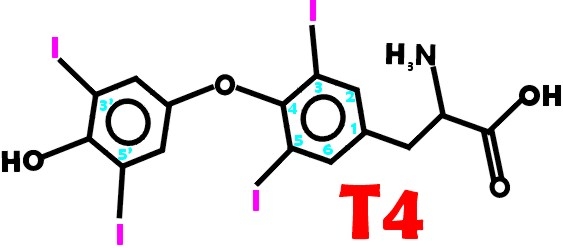
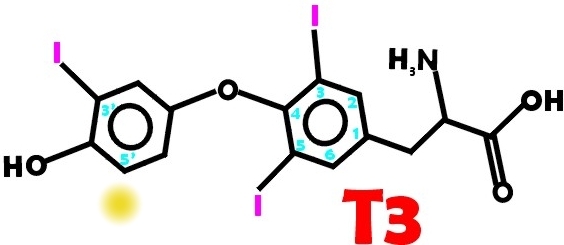
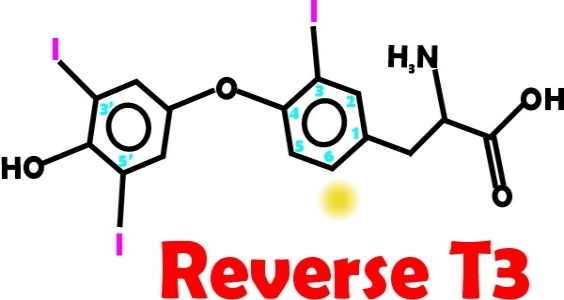
Note that T3 and rT3 have exactly the same chemical formula except for the exact position where the iodine atoms (magenta in the above diagrams) are placed on the thyronine molecule. This small difference totally changes their effect on the body:
- T3 acts like the gas pedal of a car,
- rT3 acts like the brake pedal.
The bottom line is that T3 is the hormone that primarily does the job of promoting energy production in the body, and TSH is the hormone that primarily controls the production of T3. The other hormones are part of a complex regulatory system that will be discussed next.
Control of Thyroid Function
Thyroid function can be understood like the children's story of Goldilocks and the three bears:- TOO HOT: If the body produces too much T3 then symptoms of hyperthyroidism are produced (fever, high blood pressure, nervousness, weight loss, etc).
- TOO COLD: If not enough T3 is produced then the opposite symptoms are produced (low body temperature, high cholesterol, depression, weight gain, etc).
- JUST RIGHT: The optimal balance between too much and too little. Easy to say, but not so easy to achieve.
Household Heating and Cooling System Example
It is easiest to understand the concept of a negative feedback loop by considering the engineering implementation of a simple household heating and cooling system, whose job it is to maintain the temperature inside at a constant temperature that is called the set point. For a house, a set point of about 73°F is typically chosen. The set point is chosen by the homeowner, and is entered into a device on the wall called a thermostat.
In its simplest form, a negative feedback controller loop consists of three components:
- Sensor
- Measures the current value of the parameter being controlled (in this example, the temperature).
- Controller
- Establishes the set point of the parameter being controlled (in this example, the knob or lever on the wall unit sets the temperature you want), compares the current environmental value (room temperature) to the set point (thermostat setting), and sends a control signal to the actuator (in this example, turns the heat pump on or off).
- Actuator (also called the Effector)
- Acts to change the environmental value (room temperature) to be closer to the set point (thermostat setting) by pumping heat out of the room (cool) or pumping heat into the room (warm).
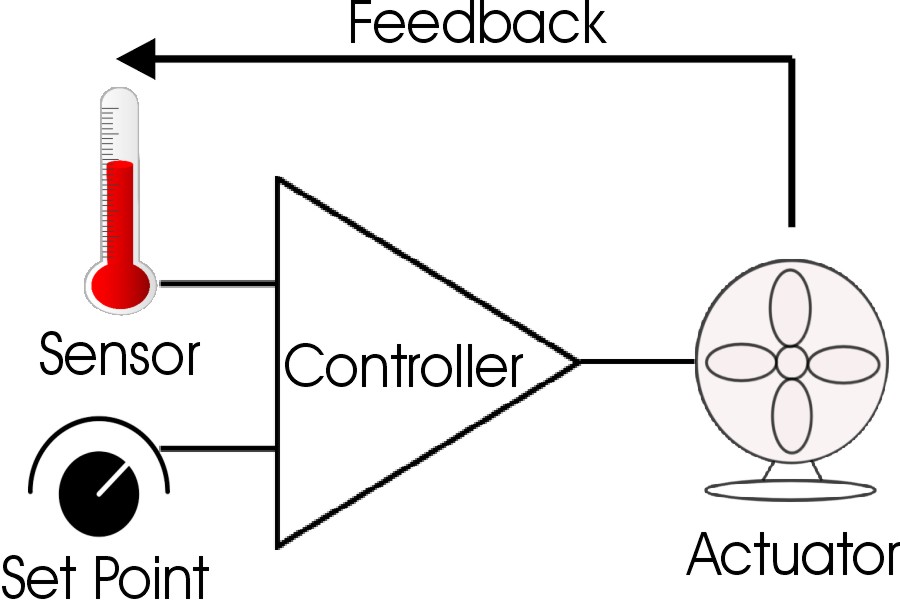
A more sophisticated system might also sense the time of day, and the controller would take into account variable costs for electricity depending on the time of day.
A still more sophisticated system might also sense the outdoor temperature, and the controller would take into account the temperature difference between outside and inside, and signal the actuator to work at maximal energy consumption for extreme differences, or more efficient lower energy consumption for smaller differences.
The most sophisticated system would also be sensitive to the presence or absence of the homeowner (and the homeowner's schedule), and be less aggressive (more energy efficient) when the homeowner is absent (or expected to be absent).
Simplified View of the Thyroid System
By analogy, a simplified view of the thyroid system works the same way, but with greater complexity in the details. There are a number of sensors in the brain that measure the body's energy reserves, needs, and T3 levels. The hypothalamus and pituitary glands act as both the sensor and controller, which calculates an appropriate set point for energy expenditure, compares that to the current status measured by the sensors, and sends a control signal to the actuator. The control signal is the hormone TSH, and the actuator is the thyroid gland, which produces T4, which is converted into T3 by various tissues throughout the body, and which tells the mitochondria in all cells of the body how much energy to make. Not only does T3 stimulate mitochondria, but it also "feeds back" to sensors in the hypothalamus and pituitary gland to help control how much TSH is released.
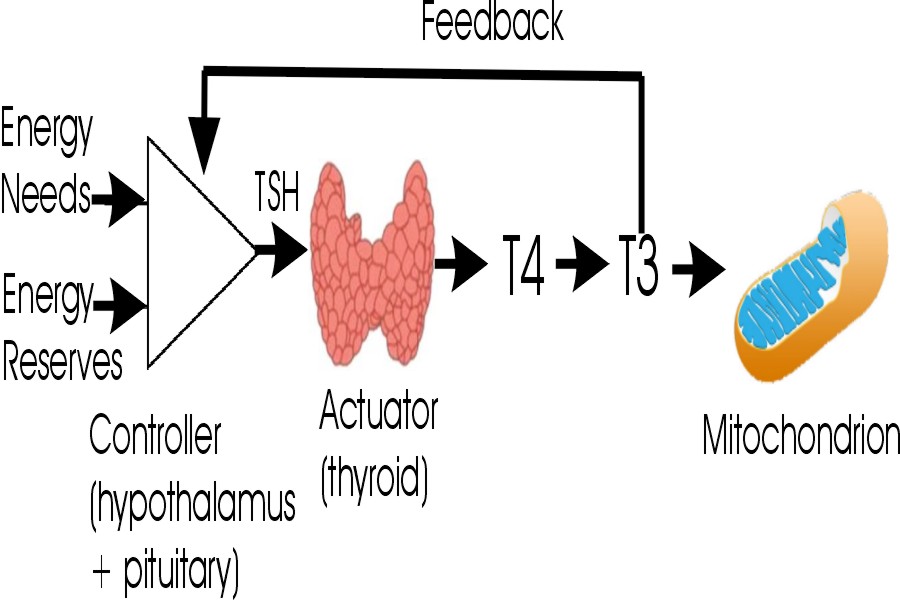
There are many different sensors involved in the thyroid control system, and the controller logic is complex. A full discussion of all the parameters that are sensed and integrated by the controller is beyond the scope of this discussion.
These concepts are enough to make your head swim. But don't feel bad. The idea is both simple in overview AND complex in detail. As Karl Johan Åström and Richard M. Murray pointed out in their book Feedback Systems: An Introduction for Scientists and Engineers:
Simple causal reasoning about a feedback system is difficult because the first system [Sensor] influences the second [Actuator] and second system influences the first, leading to a circular argument. This makes reasoning based upon cause and effect tricky, and it is necessary to analyze the system as a whole.
In the simplified thyroid system model described above, the two hormones TSH and T3 stand out as being particularly important in troubleshooting the system (diagnosing what is wrong when a patient presents with symptoms of either hyperthyroidism or hypothyroidism). TSH represents the control signal derived by the hypothalamus and pituitary from all the sensor data, and T3 represents the actuator response produced by the thyroid gland.
In our simplified view, the following diagnostic reasoning can be applied:
| Case | TSH | T3 | Medical Decision |
|---|---|---|---|
| 1 | low | low | Hypothalamus or pituitary failure |
| 2 | low | normal | Uncertain diagnosis (T3 suggests patient is fine, but TSH is out of range) |
| 3 | low | high | Thyroid medication overdose, thyroid tumor, or autoimmune disease (Hashimoto's or Graves') |
| 4 | normal | low | Thyroid failure, malnutrition or autoimmune disease (Hashimoto's) |
| 5 | normal | normal | Patient is fine |
| 6 | normal | high | Thyroid medication overdose, thyroid tumor, or autoimmune disease (Hashimoto's or Graves') |
| 7 | high | low | Thyroid failure, malnutrition or autoimmune disease (Hashimoto's) |
| 8 | high | normal | Uncertain diagnosis (T3 suggests patient is fine, but TSH is out of range) |
| 9 | high | high | Hypothalamus or pituitary tumor |
However, if only TSH is ordered, then the above decision table reduces to the following:
| Case | TSH | Medical Decision |
|---|---|---|
| 1, 2, 3 | low | Thyroid medication overdose if patient is being prescribed thyroid, or autoimmune disease otherwise (generally ignoring possible hypothalamus failure, or pituitary failure) |
| 4, 5, 6 | normal | Patient is fine (generally ignoring possible thyroid failure, malnutrition, thyroid medication overdose, or autoimmune disease) |
| 7, 8, 9 | high | Thyroid failure - prescribe (more) T4 (generally ignoring possible malnutrition, hypothalamus tumor, pituitary tumor or autoimmune disease) |
It can be seen that if only TSH is measured, then some patients in cases 4 and 6 may be misdiagnosed as being fine when they are actually hyperthyroid or hypothyroid. Furthermore, patients in cases 2 and 3 who are being prescribed thyroid medication may have their dose inappropriately reduced, and patients in cases 8 and 9 who are being prescribed thyroid medication may have their dose inappropriately increased.
From the above, it can be seen that both TSH and T3 need to be measured to properly diagnose and treat, and that in some cases additional tests for autoimmune disease, thyroid, hypothalamus or pituitary failure/tumors are also necessary.
Intermediate View of the Thyroid System
If the above is not enough to overload your brain, there another feature of the thyroid system that can be important in some cases.In our simple model, we considered the hypothalamus and pituitary as a single entity that served both as sensor and controller, and so could not distinguish between problems arising from the hypothalamus (called tertiary thyroid problems) and problems arising from the pititary (called secondary thyroid problems). In our intermediate view of the thyroid system we take note of the fact that the hypothalamus acts as the first sensor and controller, and produces the hormone TRH that travels to the pituitary gland. The pituitary gland then acts as an actuator for the hypothalamus, but also acts as a sensor and controller in producing TSH to stimulate the thyroid gland.
The TRH stimulation test can be used to evaluate the pituitary gland's ability to respond to TRH produced by the hypothalamus.
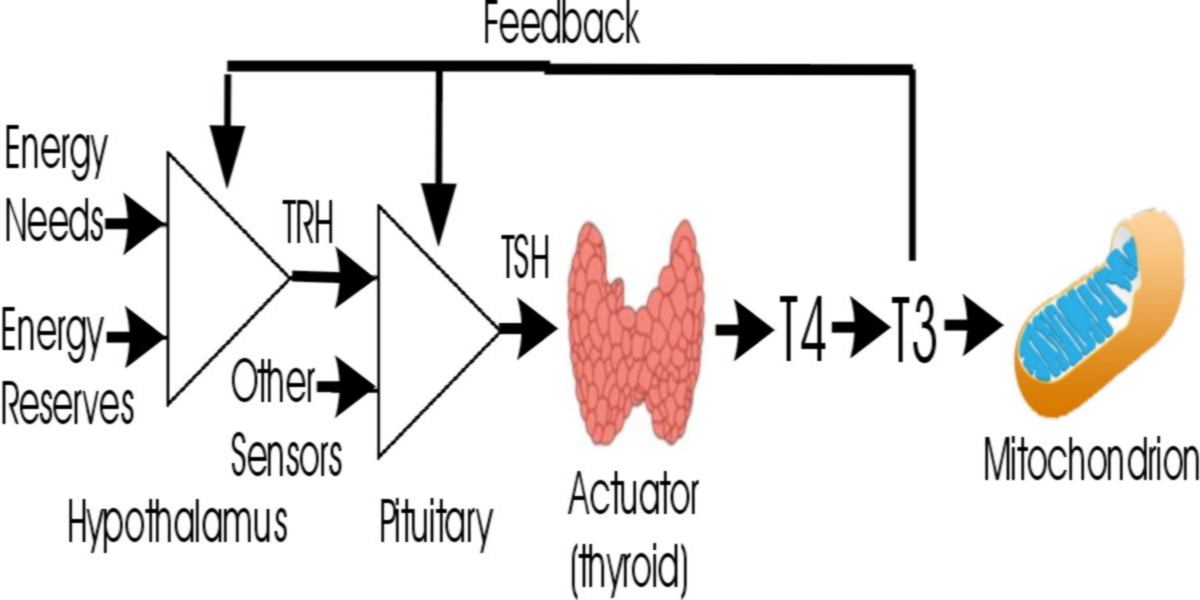
Complex View of the Thyroid System
Just when you think you understand how the thyroid system works, there is another wrinkle. The T3 hormone is carried by the blood to all cells in the body. The thyroid hormones T4 and T3 are not soluble in water, so they must be carried attached to proteins in the blood called albumin and thyroid binding globulin (TBG). When T3 and T4 are tightly bound to these carrier proteins, they are not "free" to do their job.When more T3 (and T4) than normal are bound to carrier proteins, the effective available amounts of T3 (and T4) in the blood are reduced, and symptoms of hypothyroidism can be experience despite the fact that "normal" amounts of T3 (and T4) are found.
Similarly, when less T3 (and T4) than normal are bound to carrier proteins, the effective available amounts of T3 (and T4) in the blood are increased, and symptoms of hyperthyroidism can be experienced despite the fact that "normal" amounts of T3 (and T4) are found.
These factors can be evaluated indirectly by comparing measurements of both the total T3 (tT3) and free T3 (fT3) (and the corresponding total and free T4).
In addition, the albumin and thyroid binding globulin levels can be measured directly with the CMP (comprehensive metabolic panel) and TBG tests. Liver disease or malnutrition can reduce the amount of available albumin and TBG (thereby increasing fT3 and fT4 and promoting hyperthyroid symptoms), as can certain drug interactions. Certain hormone interactions (e.g. estrogen) can have the opposite effect of enhancing the amount of available albumin and TBG (thereby decreasing fT3 and fT4 and promoting hypothyroid symptoms).
Advanced View of the Thyroid System
There is one additional major consideration. Previous discussion focused on the role of T3 in stimulating mitochondrial activity, and mentioned only in passing that the thyroid gland produces (mostly) T4, which is converted to T3 in various tissues throughout the body. It is not that simple. The conversion from T4 to T3 is also a part of the feedback control of the thyroid system. The tissues that convert T4 to T3 form yet another sensor/controller component, and based on various environmental conditions in the body may produce some mixture of T3 and reverse T3 (rT3). The possibilities include:- Normal conversion of T4 to T3 (if tT4 and fT4 are normal then so are tT3 and fT3), with little rT3 produced,
- Reduced conversion of T4 to both T3 and rT3,
- Conversion of T4 mostly to rT3.
Recall that rT3 acts as a brake, and reduces mitochondrial energy production, whereas regular T3 acts as a gas pedal, increasing mitochondrial energy production.
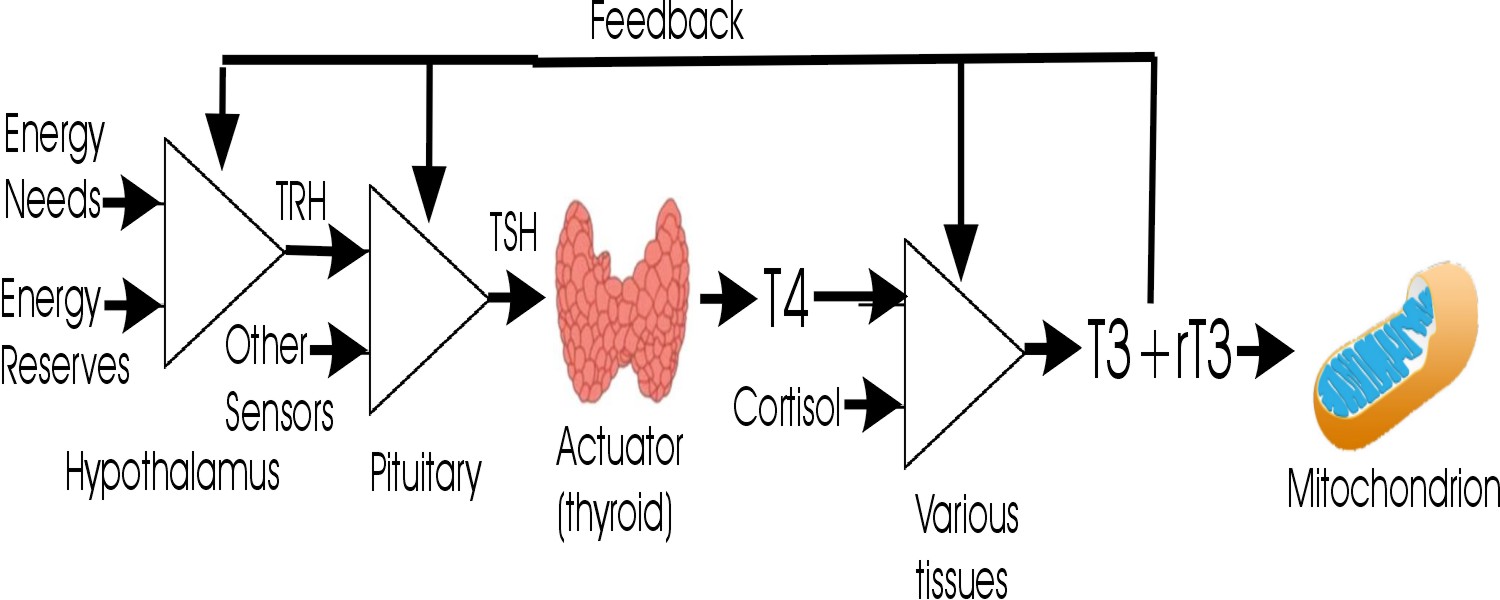
Another new piece of information is that BOTH regular and reverse T3 exert a negative feedback effect on the hypothalamus or pituitary sensors/controllers, so that high levels of either fT3 or rT3 reduce TSH production. This point leads to the observation that low TSH combined with low T3 may be due to excessive production of reverse T3. Reverse T3 (rT3) may also exert a negative feedback effect on the conversion of T4 to T3.
There are three deiodinase enzyme types (D1, D2, and D3) found in the pituitary and peripheral tissues. D2 converts T4 to T3, whereas D3 converts T4 to rT3. (D2 also converts rT3 to T2, while D3 converts T3 to T2) [Bianco2006]. The role of D1 and T2 is unclear but it has been proposed that T2 may have a role in treating edema and moderating the effects of T3.
The Adrenal Cortex Connection
The adrenal cortex produces a number of steroid hormones, including cortisol, which has been dubbed the "stress hormone." The thyroid control system senses cortisol and stress levels, and makes adjustments to TSH production and T4 conversion to T3/rT3 accordingly. Dr. Weyrich uses the analogy of an automobile to explain this concept:
Imagine that your car has 4 bald tires that could "blow out" at any moment. If you have to drive such a car, then how will that affect your driving? Most people would agree that they would use the gas pedal lightly so as to not go to fast, because the tires cannot handle too much speed. The same happens in your body. If your adrenal gland is fatigued, then it cannot make much cortisol to handle stress. The thyroid control system responds by cutting back on the "gas pedal" and not allowing too much T3 to be made, because your body cannot handle too much energy.
The Adrenal Medulla Connection
The adrenal medulla produces neurostimulating hormones called catecholamines, which include epinephrine (adrenaline) and norepinephrine. These hormones promote a "fight or flight" reaction that can resemble hyperthyroidism.
Nutrition
Nutritional deficiencies (iodine, protein, vitamins and minerals) can also interfere with proper functioning of the thyroid system, usually causing symptoms of hypothyroidism.
The Spinal Connection
Hippocrates, the "father of modern medicine", said "first look to the spine" for the cause of disease. In some cases, treatable problems with the spine can reduce blood flow to the hypothalamus and pituitary gland (the paravertebral arteries provide about 30% of the total blood flow to the brain) and nerves of the autonomic nervous system that regulate the function of the thyroid, adrenal, and digestive systems as follows (note textbooks differ on the exact details of spinal levels, and there is also anatomical variation):
- Thyroid: Parasympathetic = Vagus (CN X), and Sympathetic = C5, C6.
- Adrenal: Parasympathetic = Vagus (CN X), Sympathetic = T10-T12.
- Digestive: Parasympathetic = Vagus (CN X) and S2-S4, Sympathetic = T5-L3.
The primary action that these autonomic nerves have on the target organs is that they control the blood flow to the organs. This physiologic function can be disrupted by anything that puts pressure on the nerves, including edema due to local inflammation at the spinal roots, or boney impingement caused by subluxation of the spinal segments, bone spurring, degenerative disc disease, etc [Bentley1943], [Causey1949], [Gelfan1956], [Olmarker1991], [Rydevik1992], and the references in [AUKC2010]. This phenomena was also reported by Drs. Chung Ha Suh, Ph.D, Seth Sharpless, Ph.D., and Marvin Luttges, Ph.D at the Biomechanics Department of the University of Colorado in the 1980s, where they found that the rate of propagation of nerve action potentials from nerve roots was reduced by over 50% by applying a pressure of as little as 10 Torr pressure [reference pending].
Note that although the vagus nerve (cranial nerve X) does not originate from the spine, it does emerge from the skull through a foramen very close to atlas-occipital articulation, and swelling/inflammation at that joint can affect the vagus nerve, which controls almost the entire parasympathetic innervation of the internal organs.
The bottom line is that the thyroid, adrenal, and digestive system are affected by almost the entire spine.
Appropriate Chiropractic, Osteopathic, or Naturopathic spinal manipulation may resolve these problems without the use of any drugs or nutritional supplements. Dr. Robert Gear, Jr. discusses his theory and practice of spinal manipulation in his Trinity Broadcast Video and Manipulative Surgery Monograph.
Environmental Toxins
The heavy metal mercury has been shown to adversely affect the conversion of T4 to T3 in the peripheral tissues. [Ellingson2000] reports that exposure to low levels of mercury vapor causes a significant increase in rT3 levels, and elevation of the ratio of fT4 : fT3 (i.e. reduced conversion of T4 to T3). This data is consistent with mercury poisoning the deiodinase system responsible for the peripheral conversion of T4 to T3.
Evidently, mercury selectively deactivates the deiodinase D2, and since D2 and D3 both compete for the substrate T4, D3's relative activity is increased, thus making more rT3. Furthermore, conversion of rT3 to T2 by D2 is also inhibited, which also increases the level of rT3.
Medications
Medication (prescribed, over the counter, or recreational) side effects also need to be considered, and after all other causes are ruled out, a psychological evaluation may be indicated.
References
- [AUKC2010] Alliance of UK Chiropractors. The Vertebral Subluxation Complex. A Position Statement. August 17, 2010 (). Text: https://cdn.vortala.com/static/uploads/3/2011/11/VSC_Position_Statment_AUKC.pdf. Accessed: 08/19/2018.
- [Bentley1943] FH Bentley & W Schlapp. The Effects of Pressure on Conduction in Peripheral Nerve. J Physiol. 102, 72-82 (1943). PMID: 16991592. Text: https://physoc.onlinelibrary.wiley.com/doi/pdf/10.1113/jphysiol.1943.sp004016.
- [Bianco2006] Antonio C Bianco & Brian W Kim. Deiodinases: implications of the local control of thyroid hormone action. J Clin Invest. Oct 2; 116(10): 2571-2579 (2006). PMID: 17016550. Text: https://www.ncbi.nlm.nih.gov/pmc/articles/PMC1578599/.
- [Causey1949] G Causey & E Palmer. The effect of pressure on nerve conduction and nerve-fibre size. J Physiol. Aug 1; 109(1-2): 220-231 (1949). PMID: 15407227. Text: https://www.ncbi.nlm.nih.gov/pmc/articles/PMC1392600/pdf/jphysiol01472-0234.pdf.
- [Gelfan1956] Samuel Gelfan & IM Tarlov. Physiology of Spinal Cord, Nerve Root and Peripheral Nerve Compression. American Journal of Physiology. Vol 185 (1) March. pp 217-229 (1956). PMID: 13313775. Text: https://www.physiology.org/doi/abs/10.1152/ajplegacy.1956.185.1.217?url_ver=Z39.88-2003&rfr_id=ori%3Arid%3Acrossref.org&rfr_dat=cr_pub%3Dpubmed.
- [Ellingson2000] DG Ellingsen, J Efskind, E Haug, Y Thomassen, I Martinsen, PI Gaarder. Effects of low mercury vapour exposure on the thyroid function in chloralkali workers. J Appl Toxicol. Nov-Dec;20(6):483-9 (2000). PMID: 11180271.
- [Olmarker1991] Kjell Olmarker. Spinal nerve root compression. Nutrition and function of the porcine cauda equina compressed in vivo. Acta Orthopaedica Scandinavica, 62:sup242, 1-27 (1991). PMID: 1645923. Text: https://doi.org/10.3109/17453679109153920.
- [Rydevik1992] BL Rydevik. The effects of compression on the physiology of nerve roots. J Manipulative Physiol Ther. Jan;15(1):62-6 (1992). PMID: 1740654.